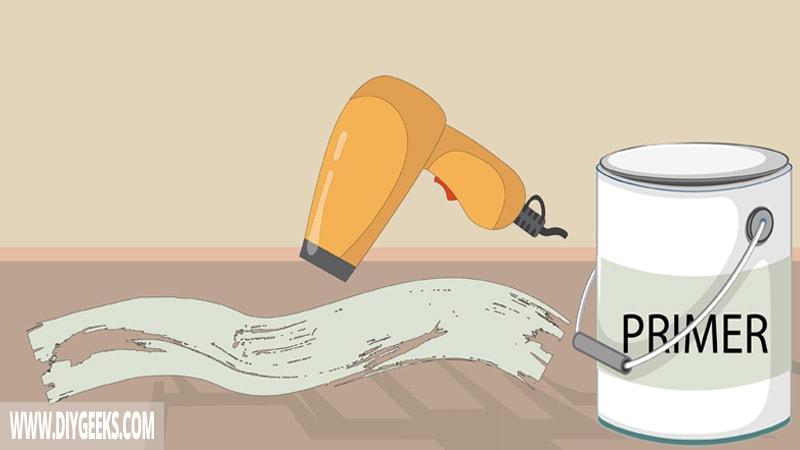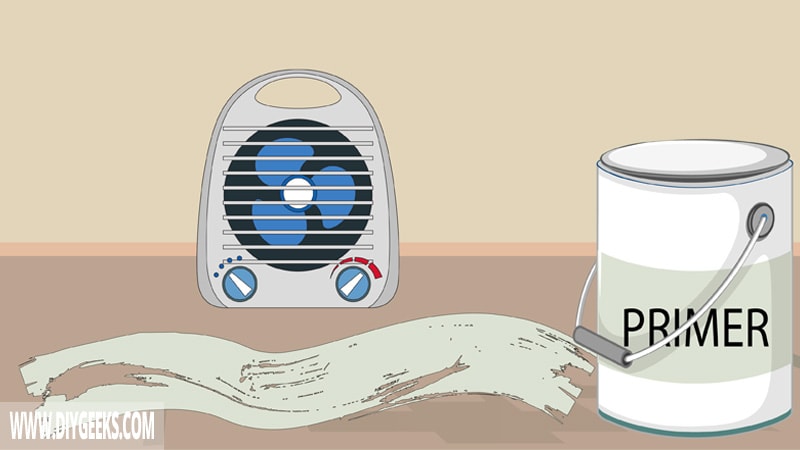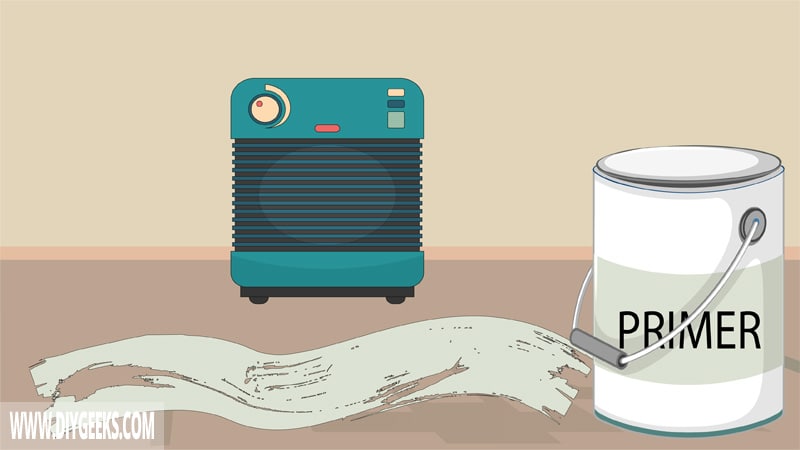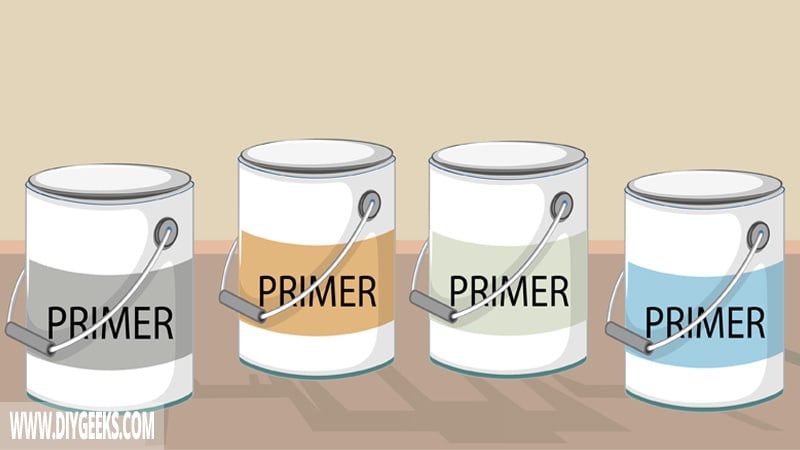Water-based primer takes less than 1 hour to dry between coats, while oil-based primer takes around 1 hour. However, its dry time is also determined by room temperature, humidity levels, and thickness of the coat.
Water-based primers dry faster than oil-based primers because water evaporates faster than oils from the coating.
To make primer dry faster, use a hairdryer, improve ventilation, and use a dehumidifier.
How Long Does Primer Take To Dry Between Coats?
Water-based primers take less than 1 hour (30-40 minutes) to dry between coats, and oil-based primers take around 1 hour to dry between coats.
Primers dry faster than paints as they are formulated with fast-drying additives and don’t have a complex formula.
This gives the primer coating enough time to dry and become hard enough to support another coating. If you re-coat it too soon, the finish may turn sticky or remain wet for longer.
If the primer coating is still wet, you can’t apply paint over it as it won’t stick and will turn the whole finish sticky. The finish will be riddled with stained spots as the moisture in the primer will bleed through the paint and cause dark stained spots.
What Factors Determine Primer Drying Time?
Factors that determine the primer drying time are listed below.
The Type of Primer
There are different types of primers — latex, oil-based, shellac, and self-priming. Each of these types has a different drying time. That’s because each has a different formula:
- Water-Based (Latex) – The water-based primer dries faster because it doesn’t have a complex formula and its solvent (water) evaporates faster. It takes less than 1 hour to dry (30-40 minutes).
- Oil-Based – Oil-based primer has a more complex formula and takes longer to dry. It uses oil as its solvent, and since oil takes longer to evaporate, the coating takes longer to dry. It dries within 1 hour.
- Shellac – Shellac primer is good at blocking stains and covering different things on a surface. It dries within 1 hour.
- Self-Priming – The self-priming primer has paint and primer in its formula. It’s a great choice if you want to save some time. It takes around 1 hour to dry.
Coating Thickness
The thickness of the coat determines how long it takes the primer to dry. The coating will take longer to dry because the evaporation rate will be slower if the coating is thick.
To make it dry faster, apply thinner coats.
The number of coats is also important — the more coats you apply, the longer they take to dry. You will have to wait for each coat to dry before you add the next one, and that adds to the total amount of time you spend completing a project.
Humidity and Temperature
The humidity and temperature levels can speed up or slow down the dry time.
If the humidity levels are too high the coating takes longer to dry because the high humidity affects (slows down) the evaporation rate. The humidity levels should be between 50-60%.
The temperature also determines the primer drying time. If the temperature is too low, the coating will take longer to dry because the evaporating process is slower on cold days. If the temperature is too high, the coating will dry too fast but it may chip off later because the paint particles aren’t bonded naturally.
The temperature should be between 40-80 °F for the coating to dry properly.
How To Make Primer Dry Faster?
To make primer dry faster, do the following things.
- Use a Hairdryer.
- Improve Ventilation.
- Use a Dehumidifier.
1. Use a Hairdryer

Since primer dries through evaporation, you can increase the heat around the coating to increase the evaporation rate. To do so, use a hairdryer.
Here’s how to do it;
- Plug in and turn on the hairdryer.
- Set the heat to medium (between 120 and 180 degrees).
- Move the hairdryer over the coating.
- Crank up the heat by 20 degrees F.
- Turn off the hairdryer after 10 minutes.
2. Improve Ventilation

Primers air-dry which means the coating will dry faster if exposed to cool air. To improve the air circulation:
- Turn on the fans.
- Open all doors and Windows.
- Open the air vents.
- Switch the air conditioner to fan or blow mode.
3. Use a Dehumidifier

High humidity or moisture level in the atmosphere means the undercoat will take longer to dry. This is very common when you paint during cold weather or the cold winter months.
A dehumidifier can help to reduce the effects of humidity on the coating. For this method, you’ll need a dehumidifier. The dehumidifier will draw moisture from the air and release dry air in the process.
Related Read: Can You Prime Over Peeling Paint?
How Long Do Different Types of Primers Take To Dry?

Different types of primers and their dry time are listed below.
Wood Primer
It takes wood primer between 30 minutes and 2 hours to dry.
It dries faster since it uses water as its solvent and has shellac in its formula. Since water evaporates faster, the coating will also dry faster. Also, wood primers are usually stain-blocking sealers that contain shellac in their formula,
Shellac is a quick-dry stain-blocking and moisture-resistant additive that makes primers prevent bleed-through. Since shellac dries fast, the primer will too.
Spray Primer
Spray primer takes around 2 hours to dry between coats.
It takes longer to dry because they contain additives like glycerin, glycol, and plastic resins. These additives are included in the formula to improve the quality of the coating. But, they also increase the dry time.
Spray primers that have plastics in the formula also take longer to dry. They can take up to 6 hours to dry enough for a top coat.
Kilz Primer
Some types of Kilz primers take 15 minutes to dry, while other types take up to 1 hour. For instance, Kilz exterior takes longer to dry than Kilz interior because it contains fewer additives and is water-based.
Check the container to know the exact dry time.
Epoxy Primer
Epoxy primer takes less than 2 hours (90 minutes) to dry between coats.
If the weather is cool, it will dry slower than when the weather is warm or hot. This is because the epoxy primer is more affected by the ambient temperature than other types.
Since it is designed for steel or metal, the primer will take longer to cure. That’s because it will take a long time for the coating to bond to the slick steel surface.
Outdoors vs. Indoors: Primer Dry Time
Outdoors
It takes between 30-60 minutes for the primer to dry outside. This is because the coating will be exposed to cool air from all angles. It will also be exposed to direct sunlight and heat making the rate of evaporation faster. This will make the coating dry quickly.
However, exterior primers can take longer to dry outside. This is because they are usually designed with additives like UV blockers to help the coating thrive in the harsh exterior environment. But, these additives take longer to evaporate which prolongs the dry time.
During cold weather, the primer will take longer to dry. This is because the atmosphere will be very moist.
Indoors
Primers take longer to dry inside than outside because the coating isn’t exposed to as much cool air. Also, the primer isn’t exposed to direct sunlight or heat. This means that the coating will dry slower.
However, you should know that during the cold winter months, primer will dry faster inside than outside. That’s because the coating inside is shielded from moisture or high humidity.
[su_youtube url=”https://www.youtube.com/watch?v=-FjQ3h12O-o”]
[sc name=”primer-dry-time”][/sc]


